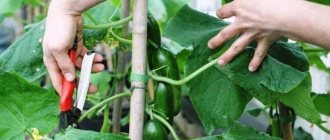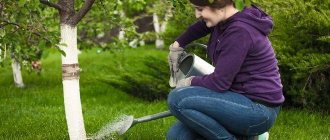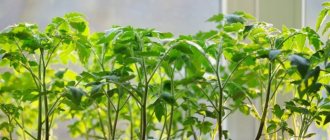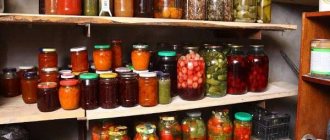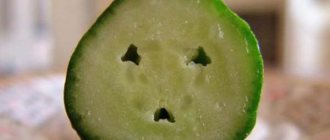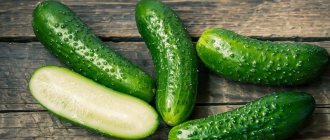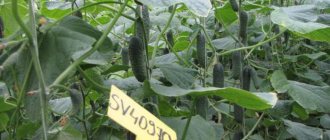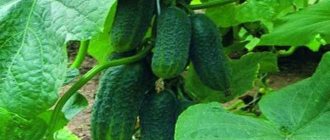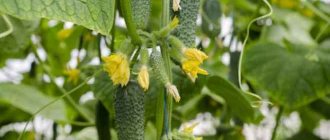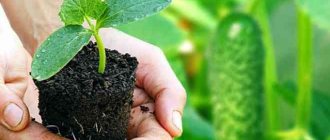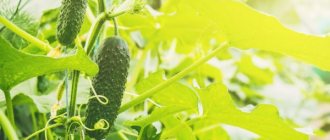Vegetable growing » Cucumbers
0
3984
Article rating
Kira Stoletova
A bountiful harvest is the merit of an attentive farmer. Knowing what vegetables are afraid of and what is necessary for their germination, you can achieve maximum returns even from the most budget variety. What is the temperature for growing cucumbers? Let us examine the most optimal conditions for the development of popular culture.
Cucumber growing temperature
At what temperature do cucumbers grow in open ground at night?
Why at night? Because it is at this time of day that the fruits receive nutrients from the leaves. In open ground, at high temperatures, fruits will grow more actively, and at moderate temperatures, the shoots and roots of the plant will grow more actively.
The best option here is the golden mean. The temperature between day and night should not differ by more than 7°C.
Optimum temperature for night growth of cucumbers
Seeds germinate at +10-12°C, and leaves and the fruits themselves form at +15-16°C. If you decide to increase the temperature during seed germination to +25°C, the process will go much faster, and sprouts will appear 5-6 days after sowing. If you increase it to +17-20°C, expect shoots on the tenth day. Carefully monitor the temperature drop; if it drops below +10°C, the sprouts will turn yellow and die.
As for soil temperature, a lot depends on the cucumber variety. Each has its own optimal germination temperature. The average favorable soil temperature at night is +16–18°C. But the seeds will germinate faster if the air temperature is slightly lower than the soil temperature.
Favorable growing temperatures
Favorable for growing plants are the average daily air temperature, slight daily temperature fluctuations, and a slow decrease in temperature at the end of the growing season.
Night temperatures for growing cucumber plants that fall below +15-+13 degrees lead to a decrease in cucumber temperature and a decrease in yield. This pattern is explained by the fact that cucumber fruits grow mainly at night. If the temperature and air humidity drop simultaneously, cucumber plants are affected by a fungal disease called powdery mildew.
Cucumbers grow most intensively in the temperature range from 20 to 30 ºС. Different varieties have their own optimal temperature for best growth. Growing cucumbers will work better if the soil temperature is slightly higher than the air temperature.
Minimum and maximum permissible temperature
The maximum permissible temperature for cucumbers is +42°C. Already at +35°C problems with fruiting begin. The ovaries dry out and fall off, spider mites appear, and the pollen becomes sterile. High temperatures contribute to the aging of canes, as the root system reduces its absorption capacity.
To ensure that cucumbers do not die in abnormal heat, it is necessary to additionally irrigate not only the beds themselves, but also the areas adjacent to them. And sprinkling contributes to less surface overheating of plants and additionally cools the soil. If possible, cover the trellises with light, light agrofibre.
Summer residents are also worried about the overcooling of their plantings. Most often this happens if there is a north wind in the region. The difficulty of open ground is that achieving constant warmth is problematic, but gardeners use some tricks that help maintain comfortable conditions:
- Cucumbers are planted along the walls of buildings on the leeward side, but where the sun's rays fall.
- Cucumber trellises are placed between rows of plants with tall stems. Thanks to the “walls,” the temperature becomes several degrees higher and creates additional shade, but in the south this method is not popular, as it can lead to overheating of the cucumbers.
Important ! In most cases, bush plants take away some of the moisture, so watering cucumbers in such a neighborhood should be treated with special responsibility.
As for the minimum temperature, at temperatures below +10°C the root system stops absorbing nutrients from the soil. As a result, the plants begin to starve and are susceptible to various diseases. If the low temperature (below +3...+4°C) persists for three days, the plant tissues begin to deteriorate, as a result of which the cucumbers die. If seeds are sown in frozen soil, they will not sprout until it warms up well. Active growth stops at temperatures below +15°C.
The night temperature regime for growing cucumbers should be without sudden changes, as this will lead to a decrease in yield. If temperature fluctuations in your region are sharp, and night temperatures are below favorable for cucumbers, grow them in a greenhouse or greenhouse.
When and how to sow seeds in the ground?
You can start sowing seeds in open ground when the ground warms up to +12-+15 degrees. It is necessary to sow in three to four terms with an interval of 5-7 days. This planting tactic is carried out in order to obtain early growth results. If the early plants do not survive, at least those sown later will remain.
When the threat of frost has passed, excess plants should be removed.
Stages of growing cucumbers.
As a rule, cucumber seeds are embedded in the ground 3-4 cm deep. But you can practice different depths of embedding them in one hole. For this purpose, make an inclined hole with a hoe or place the seeds along a slope, starting from a depth of 6-8 cm and rising to 2-3 cm. This technique will make it possible to obtain seedlings depending on the temperature and soil moisture. If the top layer is highly moistened, shallowly located seeds will sprout, and if this layer dries out, seeds that were buried deep will sprout.
When the shoots appear, loosen, and when the first real leaves appear, break through, leaving plants in rows every 12-15 cm and 3-4 per hole. At the same time, carry out the first feeding with fermented bird's milk, having previously diluted it with 5-6 parts of water or mullein solution. As an alternative, you can use diluted ammonium nitrate or urea in the amount of 15 g per bucket of water and the same amount of potassium sulfate. To remove fertilizer from plants, rinse them immediately with clean water. After 12-13 weeks, feed a second time, and before closing the lashes - a third time.
What to do if the temperature is below normal
There are several ways to help save your cucumbers from prolonged frosts. The most common way is to build a warm or manure bed.
dung ridge
At low temperatures, it will provide the plant with warmth and the necessary nutrients for growth. Do it carefully, as the active burning phase can have a bad effect on young plants.
A bed of manure is prepared 14 days before sowing the seeds. To do this, place the manure in a high bed and water it. Polyethylene will speed up the combustion process.
Steam from the ridge means it has started working. After two days of active burning, you can begin planting seeds in holes with soil. Pay attention to the thickness of the soil. It should be at least 30 cm. If there is a threat of frost, use film or spunbond (covering material). Cucumber vines that grew on manure are less likely to get diseases.
Warm ridge
This is almost the same as manure, but the biofuel used here is:
- food waste;
- leaves;
- branches;
- grass;
- tops
Note! If the seedlings are placed on an inorganic cushion and covered with film on top, then they will not be afraid of frost. This is also suitable for rainy summers, since organic matter is very humid and produces heat for the growth of cucumbers.
Advantages of warm ridges:
- arcs and shelters are easy to fix;
- the process of warming up the soil goes faster, and seeds can be sown earlier;
- there is less weed;
- drainage in the form of large branches will eliminate stagnation of water, which has a good effect on the development of the root system;
- organic matter begins to rot and warm the soil, which makes cucumbers grow better at night.
Arcs and covering material
Inexpensive kits for summer residents with plastic arches and covering material will help save cucumber vines.
Attention ! Installing arcs under the holes will protect the cucumbers from May frosts. Dense covering material will also help seedlings when cold weather sets in.
It is recommended to purchase white spunbond to protect the cucumbers from the spring cold snap. It is better to choose a density of 23 g/m². This is enough to protect the cucumbers from the cold and will also help them withstand strong winds.
If frost has damaged the leaves of cucumbers, use the drug "Epin". It will help when:
- the cucumbers are frozen;
- the leaves have turned yellow;
- It rains every day and gets colder;
- attacked by aphids or other pests.
Even with a single treatment with Epin, the plant’s immunity will be restored. Fertilizers should not be used for two weeks. It is also worth purchasing a growth stimulator.
You can restore cucumber lashes using other good means:
- "Zircon";
- "Narcissa";
- "Amulets";
- "Silka."
Fertilizers
Long low temperatures in summer have an adverse effect on cucumbers. The leaves at the tips begin to lighten, the ovaries form more slowly. In this case, they are fed with a solution of urea or urea.
Prepare this solution immediately before use. 1 tbsp. l. The drug is added to 10 liters of settled water. Dry and cloudy weather is suitable for processing cucumbers.
Reference ! You will need to save cucumbers using this method several times with an interval of 3 days until the leaves acquire a dark green color.
Traditional methods
If cold weather comes unexpectedly, but there is no covering material at hand and there is no time to make a shelter, folk methods will come to the rescue. Grass or branches can be torn and placed on top of the young cucumbers, and tied to the trellis, lowered a little lower. A layer of mulch will protect against freezing. In the morning, you can rake it out a little, but you shouldn’t remove it, as it will be needed so that moisture remains in the soil and it does not freeze.
Another option is to make shelters from roofing felt. They are removed in the morning, but at night they are good protection against frost.
Boric acid is also used as a rescue from low temperatures. A five-gram bag of powder is stirred in hot water and poured into 10 liters of water. When the sun sets, the cucumbers are sprayed with this liquid.
This treatment will not only save cucumbers from freezing, but will also make them more resistant to diseases: bacteriosis, powdery mildew, and root rot.
Temperature conditions for the growth of cucumbers in a greenhouse
Maintaining the temperature in the greenhouse is extremely important - this affects the development and growth of cucumbers, the quantity and quality of consumed nutrients.
Seedlings are planted at temperatures from +20 to +22°C. It is also optimal for further growing cucumbers in a greenhouse.
If we talk about the temperature of the earth, then in the greenhouse it should be no higher than +18°C and no lower than +16°C. To do this, you need to additionally cover the greenhouse at night.
When 7 days have passed after germination, the temperature should remain at +20°C. For more comfortable conditions, a small amount of outside air is allowed in. But you can’t remove the film completely. This can have a bad effect on the seedlings.
After 2-3 leaves appear, the greenhouse must be constantly provided with heat. The optimal temperature for this is +22-24°C.
Attention ! Temperature changes should be gradual, otherwise it will have a bad effect on young cucumbers.
How many days does it take for cucumber seedlings to sprout?
The timing of the appearance of the first shoots in seedling cups is also closely related to the temperature regime. It’s one thing to plant hatched seeds in warm, heated soil, and quite another if the soil is still quite cool.
The optimal thermal regime – 25-28°C – is maintained for pots with crops around the clock. If everything is done correctly, the first tiny leaves will appear from the substrate within 7-10 days. If the temperature is about 20°C, seedlings will take from one and a half to two weeks. At a lower temperature (from 15°C) you may not wait for germination at all. In this case, sowing will have to be repeated.
Soil fertility also affects the timing during which seedlings emerge. The richer the soil in nutrients, the faster the sprouts appear.
Tips and recommendations from experienced gardeners
And finally, a few tips from experienced summer residents who know a lot about growing cucumbers:
- Choose varieties that are least susceptible to disease.
- After the first planting, the next seeds are planted after 4-5 weeks. This is necessary so that you can enjoy the harvest in late August or early autumn.
- Always make sure that the soil of your cucumbers is slightly moist. This will protect them from the bitter taste.
- To prevent insects from attacking your crops, cover the plants with translucent material until they begin to bloom and fruit.
- Once the cucumbers are ripe, harvest them every few days. Make sure that the fruits do not turn yellow, as this takes away the strength for further fruiting.
